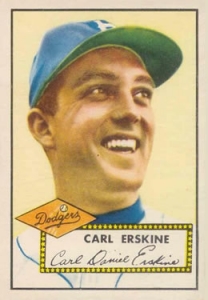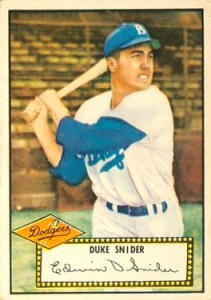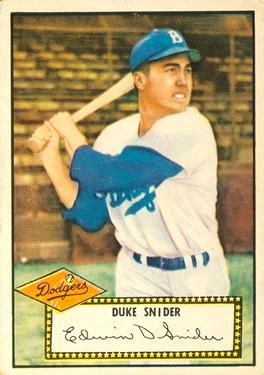October 5, 1952: Duke Snider hits and Carl Erskine pitches Dodgers to World Series lead in Game 5
“It would be so easy to believe, had you not seen it, that there couldn’t possibly be, ever, such a game as this. Having seen it, you know you never had seen one like it before and that you never could forget it. Never as long as you live.” – Frank Graham1
 Writing about Game Five of the 1952 World Series, New York Journal-American sportswriter Frank Graham was effusive in his praise of many, including Carl Erskine, Duke Snider, Carl Furillo of the Brooklyn Dodgers and the “incredible John Mize” of the New York Yankees.2
Writing about Game Five of the 1952 World Series, New York Journal-American sportswriter Frank Graham was effusive in his praise of many, including Carl Erskine, Duke Snider, Carl Furillo of the Brooklyn Dodgers and the “incredible John Mize” of the New York Yankees.2
This World Series provided more storylines to explore than a well-written murder mystery you might watch on TV. Perhaps it seemed like a hard-fought boxing match in which the opponents are exchanging punch, counterpunch, round after round. First the Dodgers, then the Yankees!
Graham understood that “[i]n the years to come, brief pieces of the story of this game will be told many times. It will be simpler to write about it then. There was so much that happened. There were so many heroes.”3
In Game One, National League Rookie of the Year Joe Black six-hit the Yankees at Ebbets Field for the 4-2 complete-game victory.4 Home runs by Jackie Robinson, Snider, and Pee Wee Reese accounted for all the Dodgers’ scoring. Two starts in the last week of the season after 54 relief appearances readied Black for that performance.
Manager Chuck Dressen’s pitching strategy was off to a good start,5 but Vic Raschi outpitched Erskine in Game Two, and his three-hit, 7-1 win evened the series.
The scene shifted to Yankee Stadium for Game Three, and the Dodgers’ Preacher Roe hurled a six-hitter to beat Eddie Lopat, 5-3. Johnny Mize pinch-hit a home run in the ninth inning in his first appearance of this Series. While it got the Yankees no closer than putting the tying run on deck, a new storyline was emerging.
For Game Four, Casey Stengel decided a change was needed at first base for the Yankees. Mize replaced Joe Collins, who was hitless in the first three games.6 Mize delivered two hits and a second home run as Allie Reynolds pitched a four-hit 2-0 shutout to tie the Series.7
As the teams took the field at Yankee Stadium for Game Five, Erskine starting for the Dodgers and Ewell Blackwell for the Yankees, the Dodgers were concerned about their own beloved first baseman, Gil Hodges. He was in the midst of a terrible batting slump. Hodges was 0-for-11 in the first four games, but dating back to the regular season, he had failed to get a hit in his last 25 plate appearances. The slump would worsen.8 Both Hodges and Mize were in the starting lineups at first base for Game Five.
Blackwell opened the second inning by walking Robinson, who drew four walks in the game to tie a World Series record.9 Robinson advanced to second when George Shuba bounced a single over the head of second baseman Billy Martin. With third baseman Gil McDougald playing in, expecting Roy Campanella to bunt, Robinson alertly stole third. Blackwell struck out Campanella, but Andy Pafko singled to score Robinson for a 1-0 Dodgers lead. Although Blackwell walked Hodges to load the bases with one out, he escaped the inning without further damage.10
When the Yankees batted in the second, it was Pafko’s defense that saved the Dodgers. With one out, Erskine walked Yogi Berra. Gene Woodling drove the ball to deep right, where only Pafko’s leaping catch kept the Yankees off the scoreboard.11 Otherwise, Erskine was near perfection, yielding only one hit over the first four innings, an inconsequential bunt single by Mickey Mantle to open the fourth.
 When Blackwell walked Hodges again to open the fifth, the Dodgers took advantage. Blackwell fielded Erskine’s bunt, but his throw to second was too late. Everyone was safe. Billy Cox’s bunt advanced the runners to scoring position, and Reese’s sacrifice fly to deep left scored Hodges. When Snider followed with a two-run homer into the right-field stands, he became the first Dodger ever to hit two home runs in a single World Series.12 The Dodgers led, 4-0.
When Blackwell walked Hodges again to open the fifth, the Dodgers took advantage. Blackwell fielded Erskine’s bunt, but his throw to second was too late. Everyone was safe. Billy Cox’s bunt advanced the runners to scoring position, and Reese’s sacrifice fly to deep left scored Hodges. When Snider followed with a two-run homer into the right-field stands, he became the first Dodger ever to hit two home runs in a single World Series.12 The Dodgers led, 4-0.
Just as quickly, the Yankees struck back in their fifth. Hank Bauer walked and successive singles by Martin and Irv Noren scored the first Yankees run. McDougald’s force-out grounder to shortstop allowed Martin to score. When Phil Rizzuto singled to advance McDougald to second, the stage was set for Mize.
Mize hit Erskine’s 1-and-2 pitch deep into the right-field stands adjacent to the Yankees bullpen, his third homer in three days. The Yankees led, 5-4. The home run was Mize’s 2,000th big-league hit, including regular-season, All-Star Game, and World Series play.13
In his book How to Hit, written the following year, Mize remembered the feeling as he circled the bases, “I had a goose-pimply feeling running up and down my spine, as any player would.”14
Not Erskine! When Dressen came to the mound after the homer, 70,536 fans plus “Oisk” had to think his day was over. Nearly two decades later, Erskine recounted to The Boys of Summer author, Roger Kahn, “Now Charlie has the ball. I’m through. The five runs have done me in.”15 But Dressen changed his mind, handed the ball back to Erskine, and left the mound.
When the Dodgers came to bat in the seventh trailing 5-4, fans had to believe that Dressen was going to pinch-hit for Erskine to lead off the inning against Yankees reliever Johnny Sain, who had taken over for Blackwell in the sixth. He didn’t. As Frank Graham put it, “[I]n the clutch in this particular game, Charlie also saw [Erskine] clearly, figured him right—and stuck with him.”16
After Erskine flied out, Cox beat out an infield hit, advanced to second on Reese’s sacrifice, and scored on Snider’s single to center. Score tied. And it remained that way into extra innings, with Erskine firmly in control for the Dodgers and Sain still pitching for the Yankees—but not without controversy.
Sain opened the Yankees’ 10th inning by hitting a slow roller behind second base, which Robinson fielded and threw to Hodges at first. Umpire Art Passarella was emphatic with the out call, but the Associated Press photo clearly showed that Sain was safe.17 The reactions? Commissioner Ford Frick admitted that the Yankees were justified in protesting the call but that Passarella was only human in making the error. As for Passarella, he retorted that “pictures don’t always tell the true story.”18 Erskine retired the next two batters and the game moved into the 11th inning.
Sain, now in his sixth inning of relief work, opened the inning by fanning Erskine. Cox followed with a single to left, advancing to third on Reese’s single to center. Snider doubled off the right-field bleacher wall, his third hit and fourth RBI of the game, and the Dodgers had the lead, 6-5.
All Erskine had to do in the bottom of the 11th inning was face Mantle, Mize, and Berra. Mantle grounded back to the pitcher. One out. For a moment it appeared that Mize’s towering fly to right would tie the game, except that Furillo made a leaping catch against the wall for the second out. Erskine then struck out Berra looking. Game over.
It was Erskine’s first World Series victory. After Mize’s dramatic home run, Erskine had retired 19 consecutive batters. “He pitched what old-timers used to call a downer, mixed with a slider and change of pace.”19 Writers hailed Erskine’s performance as a World Series gem with few equals.
How important was the Dodgers’ Game Five victory? Probability analysis by SABR author Douglas Jordan concludes that “a team that leads the World Series by one game (1-0, 2-1, or 3-2) wins the series approximately two-thirds of the time.”20 Writing on the front page of the New York Times, John Drebinger hedged a bit but seemed convinced. “Brooklyn’s first World Series championship may be lurking just around the next corner.”21
But the Yankees won Game Six and Game Seven at Ebbets Field for their fourth straight World Series title. Unfortunately for the Brooklyn Dodgers and their fans, the “next corner,” measured in time rather than place, took three more years.22
And “the incredible John Mize”? Cleveland Press sports editor Franklin Lewis, writing in Baseball Digest, saw the 39-year-old Mize as the best tear-jerk story of the 1952 World Series: “Mize’s home runs that were like the old man coming back to reclaim the family jewels.”23
As for Mize, his own feelings about Game Five remained as focused more than 25 years later. “There are a lot of great days to remember about those years with the Yankees and even if it may seem odd, I guess the day I just missed getting four home runs in three Series games was the most memorable for me.”24
Undoubtedly, Frank Graham would not have thought Mize’s feelings to be odd. After all, Big Jawn loved to hit home runs and, indeed, he was convinced by his manager to return in 1953 for one final season.
Author’s note
In his book How to Hit, Mize recounted another of his biggest thrills in baseball, hitting a grand slam in Griffith Stadium against Walt Masterson, just four weeks before Game Five.25 Mize’s homer-in-every-ballpark feat is also the subject of another Games Project essay by the author.26
The confidence exhibited by Dressen in letting Erskine bat in the top of the seventh inning with the Dodgers trailing by one run reminded the author of the circumstances just one year earlier. Bottom of the ninth at the Polo Grounds with the National League pennant at stake. Don Newcombe is tiring, Erskine and Ralph Branca are warming up, and Bobby Thomson is coming up for the Giants. Dressen calls bullpen coach Clyde Sukeforth who responds to Dressen’s query, “They are both ready. Erskine’s bouncing his curve some.”27 Enter Branca to the mound to deliver fastballs. Thomson hits “The Shot Heard ’Round the World.”28 Erskine is often asked about the best pitch in his repertoire and the answer is always the same, “The curve ball that I bounced in the Polo Grounds’ bullpen.”29
Acknowledgments
This essay was fact-checked by Laura Peebles and copy-edited by Len Levin.
Sources
The author accessed Retrosheet.org (retrosheet.org/boxesetc/1952/B10050NYA1952.htm) and Baseball-Reference.com (baseball-reference.com/boxes/NYA/NYA195210050.shtml) for box scores/play-by-play and other data. The 1952 Topps baseball cards for Duke Snider (#37) and Carl Erskine (#250) were obtained from the Trading Card Database.
Notes
1 Frank Graham, “That Unforgettable Fifth Game,” Baseball Digest, November 1952: 33.
2 Graham.
3 Graham.
4 Brian Frank, “October 1, 1952: Joe Black and Dodgers’ defense beat Yankees in Game 1,” SABR Baseball Games Project.
5 John Drebinger, “Yanks 8-5 Choice to Capture Series,” New York Times, September 28, 1952: 5-1.
6 In fact, Collins finished the series batting 0-for-12 in six games with one walk, one run scored, and six strikeouts.
7 Steven C. Weiner, “October 4, 1952: Allie Reynolds’ 4-hit shutout in Game 4 evens World Series,” SABR Baseball Games Project. The backstory to the Yankees win is recounted in this Games Project essay. The Yankees lead 1-0 in the Dodgers fifth, one out, Pafko on third, Hodges on second, Black at the plate. Dressen flashed the squeeze-play sign as Reynolds was about to deliver on a 1-and-1 count, Pafko started streaking home from third. Reynolds’ fastball was intentionally low and outside. Black could not reach the pitch, but Berra did and Pafko was tagged out. It wasn’t even close. End of rally. Dressen had forgotten that Billy Martin had played for him in 1949 in Oakland in the Triple-A Pacific Coast League and knew the squeeze-play sign.
8 Hodges finished the 1952 World Series hitting 0-for-21 with five walks, six strikeouts and one RBI. Additional discussion of the batting slump, which continued into the 1953 season, can be found at the SABR Games Project (Steven C. Weiner, “May 24, 1953: Russ Meyer ejected, Gil Hodges snaps slump as Dodgers crush Phillies,” SABR Baseball Games Project). Carl Erskine comments to the author on Gil Hodges as a teammate.
9 Before Robinson, the record of four walks in a game was most recently achieved by Babe Ruth in Game Seven of the 1926 World Series won by the St Louis Cardinals.
10 The Dodgers were all too familiar with Ewell Blackwell. He had been traded to the Yankees by the Cincinnati Reds in late August 1952. In his coverage of Game Five, New York Times sportswriter John Drebinger reminded us of one particular game earlier in May at Ebbets Field when Blackwell never got out of the first inning at Ebbets Field (Steven C. Weiner, “May 21, 1952: Dodgers rout Reds with 15-run first inning,” SABR Baseball Games Project).
11 “1952 World Series Game 5: Dodgers vs. Yankees,” YouTube.com, accessed February 6, 2023, youtube.com/watch?v=VKjgHwynfkI.
12 John Drebinger, “Dodgers Defeat Yankees, 6-5, in the 11th; Lead Series, 3-2; Snider and Erskine Star,” New York Times, October 6, 1952: 1.
13 “Tagging ’Em All on Mize’s 2000th,” The Sporting News, October 15, 1952: 12.
14 Johnny Mize to Murray Kaufman, How to Hit (New York: Henry Holt and Company, 1953), 78.
15 “Carl Erskine and the Oddest Game in World Series History,” Baseball: Past and Present, January 22, 2011, baseballpastandpresent.com/mlb/carl-erskine-and-the-oddest-game-in-world-series-history/.
16 Graham.
17 “Ball? Sure as Hell’s Not a Sea Gull—Stengel,” The Sporting News, October 15, 1952: 8.
18 “Umpires Only Human, Too, Says Frick, Defending Passarella on Disputed Call,” The Sporting News, October 15, 1952: 8.
19 “Erskine’s Plucky Pitching Gives Thriller to Dodgers,” The Sporting News, October 15, 1952: 8. Dickson defines a downer [sinker] as “an overhand curveball that drops close to the batter’s ankles.” Change of pace was “a once commonly used term for changeup.” (Paul Dickson, The Dickson Baseball Dictionary, Third Edition (New York: W.W. Norton & Company, 2009), 175, 271)
20 Douglas Jordan, “World Series Game Situation Winning Probabilities: An Update,” Baseball Research Journal, Spring 2019.
21 John Drebinger, 1.
22 Steven C. Weiner, “October 4, 1955: Brooklyn Dodgers win first World Series as ‘Next Year’ finally arrives,” SABR Baseball Games Project.
23 Franklin Lewis, “Highlights—and Low Spots,” Baseball Digest, November 1952: 36.
24 Johnny Mize to George Vass, “The Game I’ll Never Forget,” Baseball Digest, March 1979: 76.
25 Johnny Mize to Murray Kaufman, 94.
26 Steven C. Weiner, “September 7, 1952: Johnny Mize completes homer-in-every-ballpark with pinch-hit grand slam,” SABR Baseball Games Project.
27 Gary R. Parker, Win or Go Home: Sudden Death Baseball (Jefferson, North Carolina: McFarland & Company, 2002), 95.
28 Scott Ferkovich, “October 3, 1951: The Giants win the pennant!” SABR Baseball Games Project.
29 Parker, 1.
Additional Stats
Brooklyn Dodgers 6
New York Yankees 5
11 innings
Game 5, WS
Yankee Stadium
New York, NY
Box Score + PBP:
Corrections? Additions?
If you can help us improve this game story, contact us.


